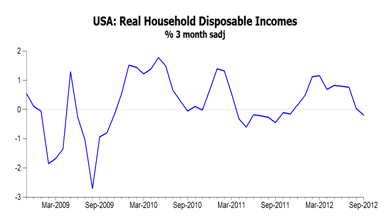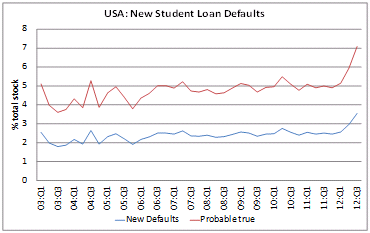Tyndall Monthly Commentary:Looking beyond the fiscal cliff
Investment markets are focused on the impending US "fiscal cliff" but the weak state of US household finances is likely to be an even bigger threat to growth in the world's biggest economy.
Monday, December 3rd 2012, 4:35PM
by Andrew Hunt

At present, financial markets seem to be enjoying a little “run” that has been based on rumours of an impending Chinese economic recovery and better liquidity trends within the US. At present, the former factor really is only “rumour”; some of China’s more recent economic data has looked a little better but the data is patchy and not always that accurate. We can, though, be more definitive over US liquidity trends, which have begun to look quite robust despite what seems to have been a marked failure of Bernanke’s latest QEP to gain traction. In fact, the cause of the latest surge in US liquidity has not been the Federal Reserve but the Federal Government itself.
It seems that the Treasury Department has been running an extremely large budget deficit over recent months (this is largely for seasonal and storm-related reasons) but what is unusual is that it has been funding this deficit not by issuing the equivalent amount of new Treasury Bonds to investors (which implicitly takes money out of the financial system) but instead by running down its own cash reserves. In a sense, the Treasury has been opening up its piggy bank and then using the money to fund the deficit, thereby moving the cash out of the government’s bank vaults, where they were sitting idle, and giving them to the real sector through the deficit and implicitly therefore to the financial sector. This factor, together with the maturing of some bank debt securities, has been sufficient to provoke the US money supply into one of its more robust periods of expansion for some time and this liquidity will support risk markets until the year end and perhaps even beyond (assuming that the political side of the Euro Crisis does not erupt again in the meantime).

The government, though, probably only has another $50-$100 billion left in its “piggy bank” that it can use to finance its deficit and therefore the policy will soon have to be suspended. At that point, if markets are to continue their rally, they will have to find further support from another quarter – be it a more solid China theme, more promises from Bernanke, or a better global economic backdrop.
At present, we regard China as simply a potential unknown factor (since China seems to have become very opaque with regard to its data of late) but we can assume that Bernanke’s “Open Mouth Policy” will be in full swing before long, particularly as Washington finally moves to address the fiscal cliff issue. Although we doubt that all the agreement will be finalised by Christmas, the basic framework of a US fiscal deal will nevertheless be in place by year end. Whatever fiscal deal is done, though, it will clearly imply some degree of tighter fiscal policy stance for the US economy and what concerns us, as we look towards 2013, is that the US consumer in particular may be poorly placed to face such an event – however mild Obama may try to make it. Therefore, it seems that the risks to US growth may be firmly to the downside at present rather than to the upside as markets seem to believe.
This view that the US consumer is in reality still in a weakened financial state is not a popular one at present. Certainly, it is much easier to sell a “story” at present about rising US house prices giving rise to better US consumer confidence and therefore supporting better US household spending trends. In fact, we suspect that this is now very much the consensus view (it certainly seems to be in the media currently) but we have a number of issues with this hypothesis, not least of all because the standard US consumer confidence index is not overly well correlated with realised spending and that, if there is a correlation, it seems to be that reported confidence lags rather than leads actual spending growth. Therefore, even if better house prices do lead to better consumer sentiment, this may not automatically lead to better consumer spending trends.
If we move away from the marketing hype that surrounds the US housing story at present, we find that US real household income growth has been notably soft of late and it seems that it will have already been a binding constraint on expenditure levels. For the US consumer, taxes are already rising, real wages are falling and much of the much-heralded employment growth that has been recorded of late has been part-time work in the hospitality sectors. Hence, actual household income trends have been weak and this has been reflected in a generally disappointing retail environment.

Optimists are suggesting that the improvement in house prices will lead consumers to save less and spend more of their incomes, thereby freeing themselves from our presumed income constraint, but we doubt that this logic will be proved correct. While we certainly do regard the revival in US housing trends as being a positive event (although the market seems to be cooling at the margin currently as uncertainty rises over the outlook for mortgage interest tax relief), we do not see the revival as a game-changer for the aggregate economy; construction is now a small part of the economy and, given the collapse in house prices since 2007, we doubt that many of today’s vendors are really selling at a “life-changing” profit given their probable historic cost levels.
More importantly, what we are definitely not seeing is any equity withdrawal from the housing market at present. Whereas during 2006-7, US households reduced their home equity by around $150 billion per annum (that is, their level of mortgage borrowing was well above their level of investment in the housing sector) but this year households have still been building home equity by holding their level of housing investment roughly constant and reducing their mortgage debts. Even during the third quarter, US households reduced their mortgage debt by a further $136 billion on a net basis while presumably raising their level of investment in the housing market. Therefore, rather than reducing their home equity by $150 billion in order to finance higher levels of consumption, households were probably raising their equity stakes at a rate that probably exceeded $600 billion annualised. This must imply that the revival in the housing market is not capable of directly financing a rise in consumption – in effect it may be doing the opposite by diverting funds away from consumption and into home purchases.
Moreover, there are also signs of mounting financial distress in the household sector that concern us at present. According to a recent report issued by the New York Federal Reserve, households borrowed an extra $30 billion in consumer credit during the third quarter and it is probably this borrowing that corresponds to the drop in savings rate that some are attributing to development in the housing market. We would attribute this rise in credit, though, not to consumers being overly confident but to them being short of money, not least of all because the months in which we have seen the fastest rates of consumer credit growth have been those in which fuel and food prices have been rising and vice versa. This makes us wonder if the rise in consumer credit is at least partially a form of consumer “distress borrowing”.
In addition, the composition of the increase in the consumer credit data also intrigued us. Within the rise in consumer credit that was announced, we find that the bulk of the increase in consumer credit seems to have been in the student loans sector and credit cards. We would attribute this dominance of student lending within the new credit data to three quite distinct factors, namely some families quite rationally substituting relatively cheap student loans for other forms of consumer finance; a rise in the student population that has been caused by the weak jobs market and increase in the number of discouraged workers that have returned to academia; and the “accidents-waiting-to-happen” schemes that are allowing students to front-load their access to student financing.
The first of these features we regard as being an “opportunistic positive” for households but the latter two features are rather less positive, since they suggest that there is a clear potential for debt problems if the discouraged workers continue to find it difficult to return to the labour market or the borrowed funds are not used “wisely”. Within the latest credit report it was announced that there were $33 billion of new student loan delinquencies in the third quarter of 2012 alone (equivalent to just over 3% of the existing stock of student debt), although the Federal Reserve has intriguingly noted that this number probably significantly understates the true situation, given that most loan officers are reluctant to announce delinquencies in this area.

Separately, even within the supposedly improving mortgage credit markets, the rate of transition of bad loans from early (30-60 days) into serious (90 days or more) delinquency increased to 26.3%, up by 2.8% from 2012Q2. These figures, like the student loan data noted above, suggest to us that the weakness in household real incomes has already become a significant threat to not only the ability of US consumers to increase their level of expenditure next year – and it may be sowing the seeds of the next “debt crisis” in the student loan system.
Therefore, we reiterate that the recent softness in the retail sales data (and we find the Black Friday sales data inconclusive with regard to underlying trends) is not storm related or a random statistical anomaly. Instead, the front end of the US economy is already weakening because of a binding income constraint even before the anticipated fiscal tightening next year takes place and we suspect that investors will soon have to weigh whether this slowdown will drive markets in the New Year or whether Bernanke’s probable promises of more action in reaction to the slowdown will dominate. At the very least, we would expect some volatility in the New Year as a result of these factors but we would not want to underestimate the markets’ ability to take Bernanke’s promises on trust for a while longer, even despite the recent relative failure of the Fed’s latest official QE to achieve very much.
Andrew Hunt
International Economist, London
Andrew Hunt International Economist London
| « Tyndall Monthly Commentary: USA buying now but will pay later | Hamish Douglass Unplugged - Latest Video from Adviser Briefing - August 2012 » |
Special Offers
Comments from our readers
No comments yet
Sign In to add your comment
| Printable version | Email to a friend |









